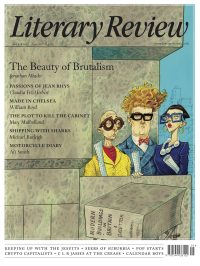Lucy Moore
La Jeune Fille Sophistiquée
Five Love Affairs and a Friendship: The Paris Life of Nancy Cunard, Icon of the Jazz Age
By Anne de Courcy
Weidenfeld & Nicolson 336pp £22
In many ways, as Anne de Courcy’s Five Love Affairs and a Friendship suggests, Nancy Cunard epitomised the Jazz Age, with her angular blonde beauty idiosyncratically accessorised with armfuls of ivory bracelets, her relentless flight from boredom, her devotion to modernity, her dependence on alcohol, her emotional emptiness and her desire to be a blazing talent in her own right. ‘Never for a second was it possible not to be aware of Nancy,’ Sybille Bedford observed. Interest in her has never abated: only four years ago Constantin Brâncuși’s gleaming brass abstract portrait of her, La Jeune fille sophistiquée (1932), sold for $71 million.
The story of her life offers the reader no happy endings. Born into great privilege in 1896, Nancy Cunard was a desperately lonely child whose sole friend was the novelist George Moore, her mother’s soon-to-be abandoned lover. A member of the fashionable Coterie set along with her friends Iris Tree and Diana Manners, as a young woman Cunard wrote poetry and pursued freedom from convention – recklessly, as her contemporaries would have put it. During the First World War, she married a man she barely knew to escape childhood and her mother; she was devastated that he, and not a paramour of three weeks whom she believed to be the love of her life, survived the war.
Divorced in the early 1920s, she became an elegantly squiffy fixture of the arty bohemian scene in London and Paris, her bedmates including T S Eliot (apparently his only one-night stand; he rewarded her by producing a bitchy portrait in an early draft of The Waste Land), Ezra

Sign Up to our newsletter
Receive free articles, highlights from the archive, news, details of prizes, and much more.@Lit_Review
Follow Literary Review on Twitter
Twitter Feed
Under its longest-serving editor, Graydon Carter, Vanity Fair was that rare thing – a New York society magazine that published serious journalism.
@PeterPeteryork looks at what Carter got right.
Peter York - Deluxe Editions
Peter York: Deluxe Editions - When the Going Was Good: An Editor’s Adventures During the Last Golden Age of Magazines by Graydon Carter
literaryreview.co.uk
Henry James returned to America in 1904 with three objectives: to see his brother William, to deliver a series of lectures on Balzac, and to gather material for a pair of books about modern America.
Peter Rose follows James out west.
Peter Rose - The Restless Analyst
Peter Rose: The Restless Analyst - Henry James Comes Home: Rediscovering America in the Gilded Age by Peter Brooks...
literaryreview.co.uk
Vladimir Putin served his apprenticeship in the KGB toward the end of the Cold War, a period during which Western societies were infiltrated by so-called 'illegals'.
Piers Brendon examines how the culture of Soviet spycraft shaped his thinking.
Piers Brendon - Tinker, Tailor, Sleeper, Troll
Piers Brendon: Tinker, Tailor, Sleeper, Troll - The Illegals: Russia’s Most Audacious Spies and the Plot to Infiltrate the West by Shaun Walker
literaryreview.co.uk